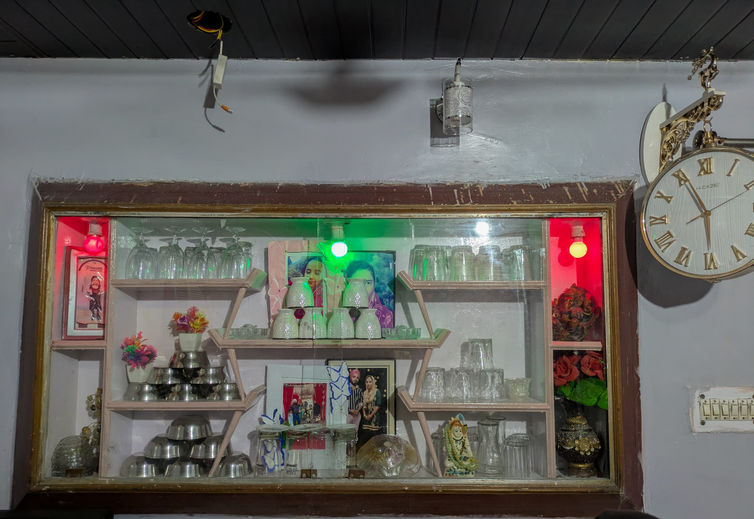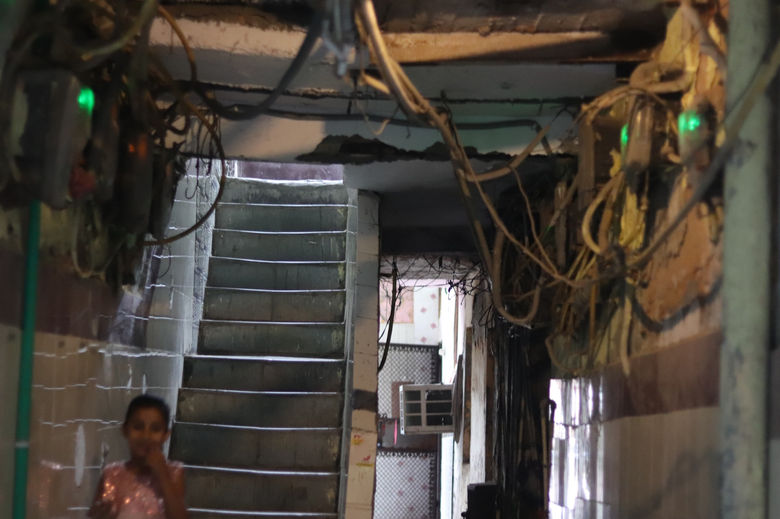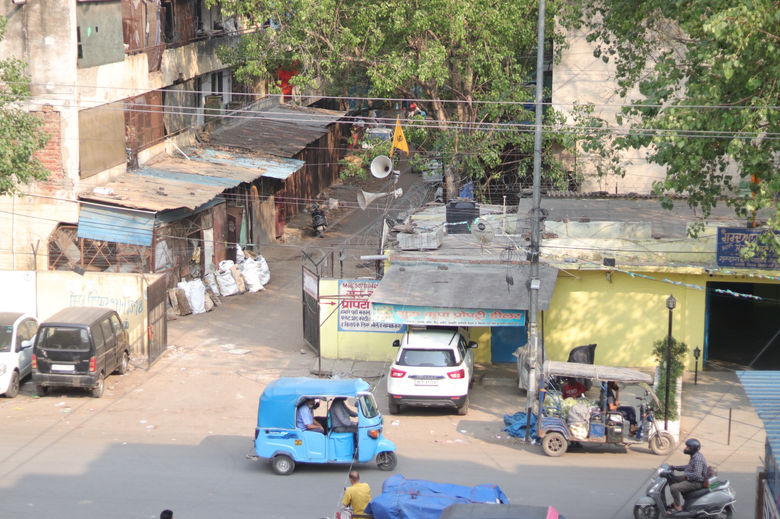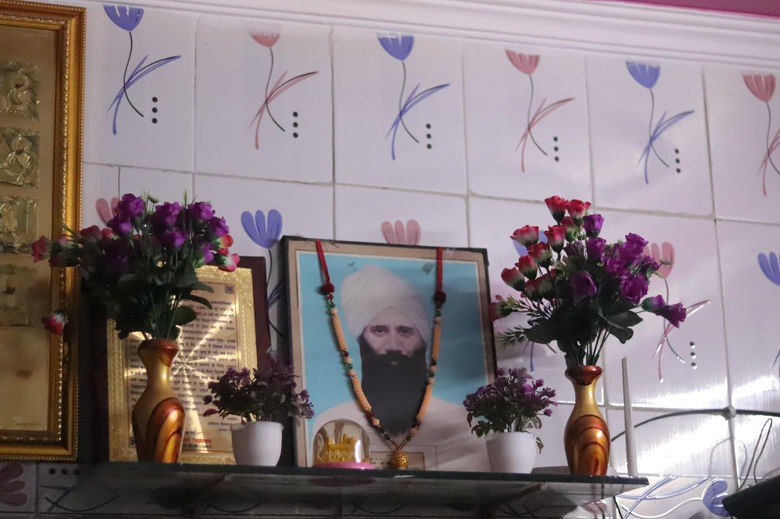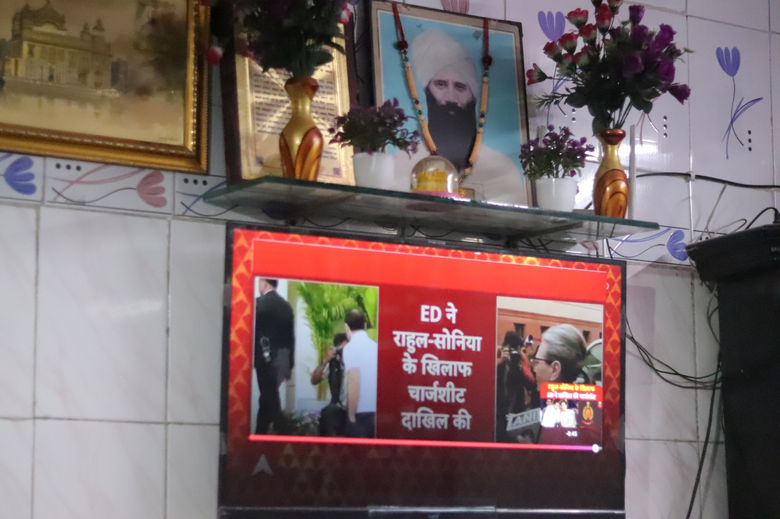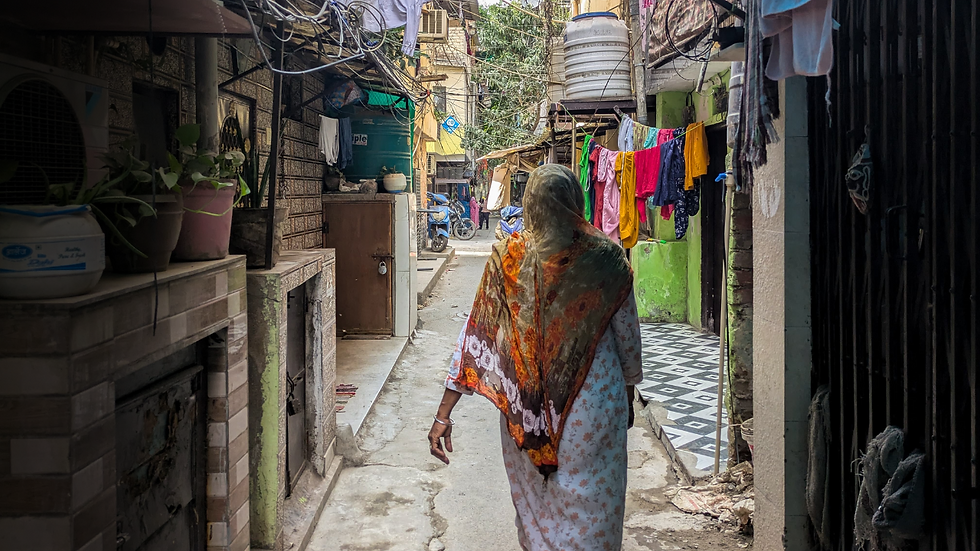
Halfway
Home
Home. Pappi Kaur sees home as a place of harmony, of love. A space free from worry. Where a 15-year-old could play all day, with pebbles in hand, imli on her tongue, lost in pitthu-pitthu and sunlight. Although poverty may live there too, comfort and ease are never missing. There is no stress. Just space to be.
Kaur, a woman in her mid-50s with a thick, greying braid that falls neatly down her back. Her face carries the quiet resilience of someone who has endured and remembered. Her voice holds both rage and grief. She wears a kirpan, dressed in a faded pink kurta with white floral patterns and a brown dupatta draped over her shoulders, seated against the patterned blue wall, recounts her story, her lived reality.
Until the morning of November 1, 1984, Block 32 of Trilokpuri (East Delhi) was home for 15-year-old Kaur and her family—a place of routine, of neighbours who knew each other by name. But that name became the very reason they were marked. "They had come with the intent to destroy both us and our homes," Kaur recalls.
On our way to the camp, one woman gave birth.
I even cut the umbilical cord myself, with a knife.
Pappi Kaur
Harleen Kaur (name changed), now in her late fifties, recalls the day her life was turned upside down. She was 17 then, living in a small juggi next to the gurudwara in Trilokpuri, a place she had called home for years. But during the violence, her juggi was set on fire. Along with her family and other survivors, mostly women, from her neighborhood, she was taken to Chilla Gaon, where a relief camp had been set up.
“I lost my husband but I am thankful that at least my honour was saved,” says Kaur. However she recalls how women were not spared, even in the relief camps. She remembers how the male gaze followed them— how some of the men that were there to help and offer aid looked at women not as survivors, but as bodies, with entitlement. Women were vulnerable, more likely to be picked out, more likely to be harmed, even in a place that was supposed to protect them.
“They were handing out rotis on one hand and eyeing the women on the other,” Kaur says. “They were watching closely, looking out for someone young, someone they found beautiful, someone they could take. In fact, they did take two young women.”
It was November, chilling cold in Delhi, but something was colder still. Not in the wind, but in the way safety had vanished. There was no warmth— not in the tents, not in the glances that lingered too long. Security was gone. And somewhere in that sharp, unforgiving air, it became clear: home was lost. Not just as a structure, but as a feeling, a promise.
Kaur recalls how they were taken from there, to Kalyanpuri then to the relief camps that had been set up at the Shahdara police station. That’s where they stayed for the next few months, in those camps.
Survivors moving together, unsure of where they were going, only certain that their homes were gone.
They were handing out rotis on one hand and eyeing the women on the other.
Harleen Kaur
Laxmi Kaur—now 70 and retired—was a Sevak at the Sultanpuri Gurudwara where she once lived. She may be confined to her bed, but not to silence. Dressed in a pale blue chunni and floral kurta, her silver hair neatly tucked back, she remains alert and engaged. She often watches the news on the television in her room, certainly with a sharp gaze. In her lap rests a book on the 1984 carnage — a reminder she holds close, not just of what was done to them, but of why remembering still matters.
Kaur remembers how families hid inside their own homes, too afraid to step out. Army rescued the survivors from Sultanpuri and gathered them in C4 Park.
“They then gathered us on buses and took us to a gurdwara, where they set up camps for us. Some of the camps were at places like Nanak Piao, Farsh Bazar, and Rakab Ganj,” Kaur recounts. “Some would give us clothes, some would give milk or ration, and some would set up langars for us. We would stand in lines and get food (Maang maang ke le aate aur phir khaate the.)”
Pappi Kaur, recalling her time in the Shahdara relief camp, remembers how families were handed huge cooking vessels "just like the ones used in jails," she says. They cooked together, using whatever they had, and then shared the food among all other families in the camp.
There was so much suffering, especially for pregnant women. “On our way to the camp, one woman gave birth. I had a chaddar—I tore it up and wrapped the baby girl in it,” says Kaur. “I even cut the umbilical cord myself, with a knife. I’ve seen so many such births during those days.”
After spending a few months in the relief camps, the survivors were eventually moved to a newly built colony in Tilak Vihar and rows of flats meant for rehabilitation. Harleen Kaur remembers how she paid a thousand rupees and was allotted a flat, having lost her 25-year-old husband to the violence.
"Chits were there," she says. "I picked one and got this flat." Although people living in those flats figured out that each flat was a mirror image of the other. One kitchen, one bathroom, a single room, and a bulb.
Tilak Vihar, shaped by the 1984 anti-Sikh violence, where families have rebuilt their homes and lives.
After the survivors were moved to Tilak Vihar and given these new ‘homes,’ they began to resettle, however, this time with fewer family members.
Many of the widowed women were given jobs by the government. Laxmi Kaur remembers, "My mother also got a job."
The women who worked, including her mother, bore a double burden. "My mother got a job at a school where she was responsible for things like providing drinking water. She was often scolded for not having the proper etiquette," she recalls.
These were women who had rarely stepped outside their homes, as their husbands would take care of everything. Kaur reflects on the heavy load those women carried, the grief on one side and the constant pressure to be ‘civilized’ on the other.
She remembers stepping out of her small, crowded flat each day to work in a nearby neighborhood, Tilak Nagar, as a house help in a well-off Sikh household. She worked there for three years, until she was married off at the age of 18.
"Every Monday, they would give me essentials,” she says. “Paanch kilo aatta (5 kg flour), aik namak ki theli (a packet of salt), sau gram chai patti (100g tea), aik dal ka packet (a packet of pulses),” This seemed enough to her at that time.
Now, for the sake of their younger generations, they had to carry on with their lives. And over time, they made homes out of the houses, those four walls allotted to them.
Kaur speaks as she shows the flat she now lives in with her family.
“After our flat was allotted, my mother bought two more from the money she got as compensation—one for my brother, and this one for me after I got married. Because we were a big family.”
She pauses, remembering the condition it was in. “When I moved in, it was nothing but a khandar, a ruin. I had to take a loan of one lakh just to get plastering, paint, and a new roof casting done. It took me almost ten years to pay off that loan,” she adds. “What you see now is after another round of repairs we did a couple of years ago, again on loan. There are 11 of us living here.”
Pappi Kaur talks about rebuilding her home in Tilak Vihar. She recalls what they were given, and what they've made of it.
Sitting in her living room, she explains how she made a home out of this small flat and there’s a little happiness. Around her, the signs are everywhere: a wall painted blue with white floral patterns, carefully matched with curtains in the same shade. There’s a row of potted plants near the balcony, a painting of the Sikh Gurus hung on walls, and a glittering photo of the Golden Temple. Every corner reflects the care she’s poured into it.
In the same spirit, Harleen Kaur says, “mujhe ghar pasand hai (I like homes),” showing her love for keeping her space beautiful. She has styled it with handmade photo frames, paintings, ceramics, and carefully placed cups– small details that make it feel warm.
Every year in November, Pappi Kaur along with other survivors go to Trilokpuri. Buses full of people come together for Paath Sahib in the Trilokpuri Gurdwara, which was burnt down in 1984 but is now rebuilt, just like their burnt-down colonies and homes. There are structures that are new in appearance, but they are not theirs. All they see is ruins.

